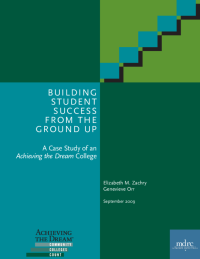Building Student Success From the Ground Up
A Case Study of an Achieving the Dream College
In 2003, Lumina Foundation for Education launched a bold, national initiative aimed at improving community college students’ success — that is, helping students remain in school, improve their performance, and ultimately graduate with certificates or degrees — particularly among low-income students and students of color. Now encompassing 102 institutions in 22 states, Achieving the Dream: Community Colleges Count supports colleges through an institution-wide improvement process focused on the use of evidence to inform decisions about programming and practice. The goal for colleges is to develop a "culture of evidence" in which a broad spectrum of faculty, staff, and administrators review data on student outcomes to identify priority areas for reform, develop strategies for improvement, implement and evaluate those strategies, and institutionalize those that yield evidence of increasing student success. The initiative provides both funding and expert consultation to help colleges through this process.
Guilford Technical Community College, in Jamestown, North Carolina, joined the first cohort of colleges to participate in Achieving the Dream in 2004. In line with the objectives of the initiative, Guilford has made great strides over the past five years in becoming a data-driven, success-oriented institution. Its numerous strategic interventions were developed to address identified priorities for student success, especially for developmental education students and first-year students. Furthermore, these strategies have been systematically evaluated and improved based on evidence of student achievement. This case study draws from Guilford’s experience implementing Achieving the Dream to highlight what colleges may achieve and the challenges they may face in undertaking a similar process of institutional reform.
Key Findings
- Building a culture of evidence: Guilford overcame initial setbacks with data collection and analysis by investing in its institutional research (IR) capacity, including both technological systems and staff expertise. Its IR department now informs decision making with systematic program evaluations and disseminates knowledge about data analysis across the college.
- Developing strategies and engaging stakeholders: Guilford’s strategic interventions reinforce its identified priorities for student success and are augmented by professional development opportunities for faculty and staff. Several of these strategies have been sustained and expanded based on promising trends in persistence and course completion.
- Institutionalizing Achieving the Dream: High-level commitment from Guilford’s leadership has helped the college to embed its student success agenda into institutional decision-making processes. Strategic planning is now informed by the college’s "scorecard," which establishes goals for institutional performance and monitors progress against these benchmarks. Guilford has observed promising increases along some of the performance indicators in its scorecard, including increased persistence and graduation rates.
Each chapter in the report concludes with lessons, both for colleges and for the Achieving the Dream initiative, about how to build a culture of evidence to increase students’ rate of success.






